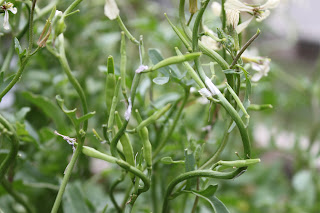How to collect Rocket seed (tips by
organic garden designer: SDC)
1.
Once the plant has ‘gone to
flower’ (flowered) it will produce long seed pods.
2.
Let the seed pods mature on the
plant and then pick them.
3.
Place them on a plate or aluminum
baking dish away from direct sunlight to dry out
4.
Once they have dried out,
crunch the dried pods in your hands to separate the seeds which can be sifted
into a colander to separate seed pods
5.
Place the seeds in a paper bag
or envelope, label, date and store in a dark dry place, ready to be used again.
NOTES:
·
Rocket seed scan be sewn and grown
regularly through most seasons is Australia (Southern parts avoid summer).
·
Best to collect seed from you
best producing plant(s)
. Refer to our blog on seed raising guide








